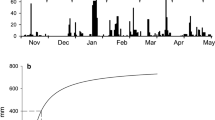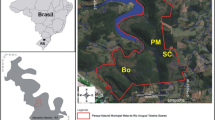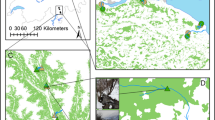Abstract
Ecological flows between habitats are vital for predicting and understanding structure and function of recipient systems. Ecological flows across riparian areas and headwater intermittent streams are likely to be especially important in many river networks because of the shear extent of these interfaces, their high edge-to-width ratio, and the alternation of wet and dry conditions in intermittent channels. While there has been substantial research supporting the importance of riparian-stream linkages above-ground, comparatively less research has investigated below-ground linkages. We tested the hypothesis that riparian roots are colonized by invertebrates as a food source within stream beds of intermittent headwater streams. We compared benthic invertebrate assemblages colonizing three types of buried substrates (leaves, roots, and plastic roots) among three intermittent Coastal Plain streams, each with a different riparian management treatment (clearcut, thinned, and reference), over a 1-year period. Invertebrate density was significantly lower in root litterbags than in plastic roots litterbags, but neither differed from densities in leaf litterbags. Total invertebrate abundances, however, were significantly higher in leaf and root litterbags compared to abundances in plastic root litterbags. Invertebrate biomass and richness did not vary among substrates, but invertebrate density, abundance, and richness all declined from the wet phase (September–December) through the dry phase (June–August). Meiofauna and aquatic dipterans were the primary colonizing invertebrates during the wet phase. Relative abundance of terrestrial taxa increased during the dry phase, but their absolute abundance remained lower than aquatic taxa during the wet phase. Invertebrate composition did not differ among substrate types, but was significantly different among streams and time periods. Cumulative number of dry days, degree days, and redox depth all strongly correlated with assemblage structure as indicated by ordination scores. Our results suggest that subsurface invertebrates respond to leaves and roots as food sources, but assemblage composition is not substrate specific. Colonization of leaves and roots within stream beds by aquatic and terrestrial taxa supports the idea that headwater intermittent streams are important interfaces for the reciprocal exchange of energy and materials between terrestrial and aquatic ecosystems.





Similar content being viewed by others
References
Adis J, Junk WJ (2002) Terrestrial invertebrates inhabiting lowland river floodplains of Central Amazonia and Central Europe: a review. Freshw Biol 47:711–731. doi:10.1046/j.1365-2427.2002.00892.x
Benke AC, Huryn AD, Smock LA, Wallace JB (1999) Length-mass relationships for freshwater macroinvertebrates in North America with particular reference to the southeastern United States. J North Am Benthol Soc 18:308–343
Boulton AJ, Foster JG (1998) Effects of buried leaf litter and vertical hydrologic exchange on hyporheic water chemistry and fauna in a gravel-bed river in northern New South Wales, Australia. Freshw Biol 40:229–243. doi:10.1046/j.1365-2427.1998.00345.x
Bridgham SD, Faulkner SP, Richardson CJ (1991) Steel rod oxidation as a hydrologic indicator in wetland soil. Soil Sci Soc Am J 55:856–862
Burton TM, Likens GE (1973) The effect of strip-cutting on stream temperature in the Hubbard Brook Experimental Forest, New Hampshire. BioScience 23:433–435
Cloe WW, Garman GC (1996) The energetic importance of terrestrial arthropod input to three warm-water streams. Freshw Biol 36:105–114. doi:10.1046/j.1365-2427.1996.00080.x
Conners ME, Naiman RJ (1984) Particulate allochthonous inputs: relationships with stream size in an undisturbed watershed. Can J Fish Aquat Sci 41:1473–1484. doi:10.1139/f84-181
Crenshaw CL, Valett HM, Tank JL (2002) Effects of coarse particulate organic matter on fungal biomass and invertebrate density in the subsurface of a headwater stream. J North Am Benthol Soc 21:28–42
Dieterich M, Anderson NH (1998) Dynamics of abiotic parameters, solute removal and sediment retention in summer-dry headwater streams of western Oregon. Hydrobiologia 379:1–15. doi:10.1023/A:1003423016125
Dieterich M, Anderson NH, Anderson TM (1997) Shredder-collector interactions in temporary streams of western Oregon. Freshw Biol 38:387–393. doi:10.1046/j.1365-2427.1997.00252.x
Dudgeon D, Wu KKY (1999) Leaf litter in a tropical stream: food or substrate for macroinvertebrates? Arch Hydrobiol 146:65–82
Dufrêne M, Legendre P (1997) Species assemblages and indicator species: the need for a flexible asymmetrical approach. Ecol Monogr 67:345–366
Egglishaw HJ (1964) The distributional relationship between the bottom fauna and plant detritus in streams. J Anim Ecol 33:463–476
Entrekin SA, Rosi-Marshall EJ, Tank JL, Hoellein TJ, Lamberti GA (2007) Macroinvertebrate secondary production in 3 forested streams of the upper Midwest, USA. J North Am Benthol Soc 26:472–490
Field JG, Clarke KR, Warwick RM (1982) A practical strategy for analysing multispecies distribution patterns. Mar Ecol Prog Ser 8:37–52
Fritz KM, Feminella JW, Colson C, Lockaby BG, Governo R, Rummer RB (2006a) Biomass and decay rates of roots and detritus in sediments of intermittent Coastal Plain streams. Hydrobiologia 556:265–277. doi:10.1007/s10750-005-1154-9
Fritz KM, Johnson BR, Walters DM (2006b) Field operations manual for assessing the hydrologic permanence and ecological condition of headwater streams. EPA 600/R-06/126. USEPA Office of Research and Development, National Exposure Research Laboratory, Cincinnati, OH, USA http://www.epa.gov/eerd/manual/headwater.htm
Goodey T, Goodey JB (1963) Soil and freshwater nematodes. Wiley, NY
Governo R, Lockaby BG, Rummer B, Colson C (2004) Silvicultural management within streamside management zones of intermittent streams: effect on decomposition, productivity, nutrient cycling, and channel vegetation. South J Appl For 28:211–224
Gregory KJ, Gurnell AM (1988) Vegetation and river channel form and process. In: Viles HA (ed) Biogeomorphology. Basil Blackwell, Oxford, pp 11–42
Horton RE (1945) Erosional development of streams and their drainage basins; hydrophysical approach to quantitative morphology. Bull Geol Soc Am 56:275–370
Kawaguchi Y, Nakano S (2001) Contribution of terrestrial invertebrates to the annual resource budget for salmonids in forest and grassland reaches of a headwater stream. Freshw Biol 46:303–316. doi:10.1046/j.1365-2427.2001.00667.x
Kedzierski WM, Smock LA (2001) Effects of logging on macroinvertebrate production in a sand-bottomed, low-gradient stream. Freshw Biol 46:821–833. doi:10.1046/j.1365-2427.2001.00712.x
Krantz GW (1978) A manual of acarology, 2nd ed. Oregon State University, Corvallis, OR
Lowrance R (1992) Groundwater nitrate and denitrification in a coastal plain riparian forest. J Environ Qual 21:401–405
Maamri A, Chergui H, Pattee E (1997) Leaf litter processing in a temporary northeastern Moroccan river. Arch Hydrobiol 140:513–531
Mason CF, MacDonald SM (1982) The input of terrestrial invertebrates from tree canopies to a stream. Freshw Biol 12:305–311. doi:10.1111/j.1365-2427.1982.tb00624.x
McCune B, Grace JB (2002) Analysis of Ecological Communities. MjM Software Design. Gleneden Beach, OR
Merritt RW, Cummins KW (eds) (1996) An introduction to the aquatic insects of North America, 3rd edn. Kendall/Hunt, Dubuque
Metzler GM, Smock LA (1990) Storage and dynamics of subsurface detritus in a sand-bottomed stream. Can J Fish Aquat Sci 47:588–594. doi:10.1139/f90-067
Montgomery DR, Dietrich WE (1989) Source areas, drainage density, and channel initiation. Water Resour Res 25:1907–1918
Moon HP (1956) Observations on a small portion of a drying chalk stream. Proc Zool Soc London 126:327–333
Murphy ML, Hawkins CP, Anderson NH (1981) Effects of canopy modification and accumulated sediment on stream communities. Trans Am Fish Soc 110:469–478. doi:10.1577/1548-8659(1981)110<469:EOCMAA>2.0.CO;2
Nakano S, Murakami M (2001) Reciprocal subsidies: dynamic interdependence between terrestrial and aquatic food webs. Proc Nat Acad Sci 98:166–170
Pennak RW (1989) Fresh-water invertebrates of the United States, 3rd ed. Wiley, NY
Pinay G, Ruffinoni C, Wondzell S, Gazelle F (1998) Change in groundwater nitrate concentration in a large river floodplain: denitrification, uptake, or mixing. J North Am Benthol Soc 17:179–189
Poff NL, Palmer MA, Angermeier PL, Vadas RL, Hakenkamp CC, Bely A, Arensburger P, Martin AP (1993) Size structure of the metazoan community in a Piedmont stream. Oecologia 95:202–209. doi:10.1007/BF00323491
Price K, Suski A, McGarvie J, Beasley B, Richardson JS (2003) Communities of aquatic insects of old-growth and clearcut coastal headwater streams of varying flow persistence. Can J For 33:1416–1432
Richardson JS (1992) Food, microhabitat, or both? Macroinvertebrate use of leaf accumulations in a montane stream. Freshw Biol 27:169–176. doi:10.1111/j.1365-2427.1992.tb00531.x
Robertson AL, Milner AM (2001) Coarse particulate organic matter: a habitat or food resource for the meiofaunal community of a recently formed stream? Arch Hydrobiol 152:529–541
Smith JJ, Lake PS (1993) The breakdown of buried and surface-placed leaf litter in an upland stream. Hydrobiologia 271:141–148
Smock LA (1990) Spatial and temporal variation in organic matter storage in low-gradient, headwater streams. Arch Hydrobiol 118:169–184
Strayer DL, May SE, Nielsen P, Wollheim W, Hausam S (1997) Oxygen, organic matter, and sediment granulometry as controls on hyporheic animal communities. Arch Hydrobiol 140:131–144
Strommer JL, Smock LA (1989) Vertical distribution and abundance of invertebrates within the sandy substrate of a low-gradient headwater stream. Freshw Biol 22:263–274. doi:10.1111/j.1365-2427.1989.tb01099.x
Thorne CR (1990) Effects of vegetation on riverbank erosion and stability. In: Thornes JB (ed) Vegetation and erosion: processes and environments. Wiley, Chichester, pp 125–144
Tillman DC, Moerke AH, Ziehl CL, Lamberti GA (2003) Subsurface hydrology and degree of burial affect mass loss and invertebrate colonization of leaves in a woodland stream. Freshw Biol 48:98–107. doi:10.1046/j.1365-2427.2003.00976.x
Trayler KM, Davis JA (1998) Forestry impacts and the vertical distribution of stream invertebrates in south-western Australia. Freshw Biol 40:331–342. doi:10.1046/j.1365-2427.1998.00337.x
Wang Z, Goonewardene LA (2004) The use of MIXED models in the analysis of animal experiments with repeated measures data. Can J Anim Sci 84:1–11. doi:10.4141/A03-123
Whitman RL, Clark WJ (1984) Ecological studies of the sand-dwelling community of an east Texas stream. Freshw Invert Biol 3:59–79
Williams DD (2006) The biology of temporary waters. Oxford University Press, Oxford
Wishart MJ (2000) The terrestrial invertebrate fauna of a temporary stream in southern Africa. Afr Zool 35:193–200
Wright AB, Smock LA (2001) Macroinvertebrate community structure and production in a low-gradient stream in an undisturbed watershed. Arch Hydrobiol 152:297–313
Wynn TM, Mostaghimi S, Burger JA, Harpold AA, Henderson MB, Henry L-A (2004) Variation in root density along stream banks. J Environ Qual 33:2030–2039
Zar JH (1984) Biostatistical analysis, 2nd edn. Prentice-Hall, Englewood Cliffs
Acknowledgments
We thank A. Bakhityarov, B. Roland, R. Governo, C. Colson, G. Lockaby, and R. Rummer for laboratory and logistical support, Andrew Boulton, Allison Roy, Brent Johnson, Michael Moeykens, and two anonymous reviewers for comments on earlier drafts. This project was funded in part by a cooperative research agreement between the USFS, International Paper, and the Alabama Agricultural Experiment Station. Although this work was reviewed by USEPA and approved for publication, it might not necessarily reflect official Agency policy. Mention of trade names or commercial products does not constitute endorsement or recommendation for use.
Conflict of interest
None.
Author information
Authors and Affiliations
Corresponding author
Additional information
This article belongs to the Special Issue “Recent Perspectives on Temporary River Ecology”.
Rights and permissions
About this article
Cite this article
Fritz, K.M., Feminella, J.W. Invertebrate colonization of leaves and roots within sediments of intermittent Coastal Plain streams across hydrologic phases. Aquat Sci 73, 459–469 (2011). https://doi.org/10.1007/s00027-011-0192-9
Received:
Accepted:
Published:
Issue Date:
DOI: https://doi.org/10.1007/s00027-011-0192-9




